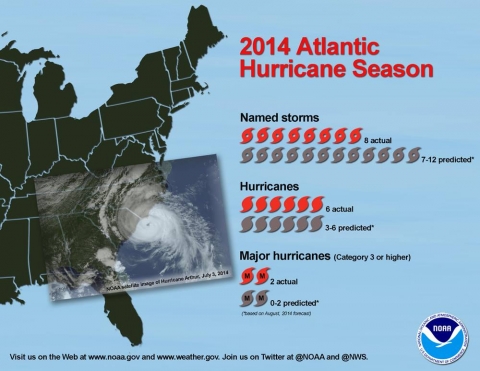Nov242014
Posted at 5:28 PM
The Atlantic hurricane season will officially end November 30, and will be remembered as a relatively quiet season as was predicted. Still, the season afforded NOAA scientists with opportunities to produce new forecast products, showcase successful modeling advancements, and conduct research to benefit future forecasts.
“Fortunately, much of the U.S. coastline was spared this year with only one landfalling hurricane along the East Coast. Nevertheless, we know that’s not always going to be the case,” said Louis Uccellini, Ph.D., director of NOAA’s National Weather Service. “The ‘off season’ between now and the start of next year’s hurricane season is the best time for communities to refine their response plans and for businesses and individuals to make sure they’re prepared for any potential storm.”
Some of the new and experimental products and services and research opportunities this year included:
- The upgrade of the Hurricane Weather Research and Forecasting (HWRF) model in June with increased vertical resolution and improved physics produced excellent forecasts for Hurricane Arthur’s landfall in the Outer Banks of North Carolina, and provided outstanding track forecasts in the Atlantic basin through the season.
- In 2014, NOAA's National Hurricane Center introduced an experimental five-day Graphical Tropical Weather Outlook to accompany its text product for both the Atlantic and eastern North Pacific basins. The new graphics indicate the likelihood of development and the potential formation areas of new tropical cyclones during the next five days.
- NHC also introduced an experimental Potential Storm Surge Flooding Map for those areas along the Gulf and Atlantic coasts of the United States at risk of storm surge from an approaching tropical cyclone. First used on July 1 as a strengthening Tropical Storm Arthur targeted the North Carolina coastline, the map highlights those geographical areas where inundation from storm surge could occur and the height above ground that the water could reach.
- NOAA and NASA’s missions involving the Global Hawk, an unmanned aircraft that flies at higher altitudes and for longer periods of time than manned aircraft, allowed scientists to sample weather information off the west coast of Africa where hurricanes form, and also to investigate Hurricane Edouard’s inner core with eight crossings over the hurricane’s eye.
- NOAA used the much smaller Coyote, an unmanned aircraft system released from NOAA’s hurricane hunter manned aircraft, to collect wind, temperature and other weather data in hurricane force winds during Edouard. The Coyote flew into areas of the storm that would be too dangerous for manned aircraft, sampling weather in and around the eyewall at very low altitudes.
- In addition, NOAA’s Hurricane Hunter aircrafts gathered data in Hurricanes Arthur, Bertha and Cristobal, providing information to improve forecasts and to test, refine and improve forecast models.
The 2015 hurricane season begins June 1 for the Atlantic Basin and central North Pacific, and on May 15 for the eastern North Pacific. NOAA will issue seasonal outlooks for all three basins in May. Learn how to prepare at hurricanes.gov/prepare and FEMA’s Ready.gov.




